A group of us each made a plain doll body then circulated the dolls around our group so we all worked on each doll, then we had a party when the completed dolls were given back to their owners.
This was my work on "Khadira' - her owner wanted an eastern theme so I researched the art of Mehndi painting and decorated her hands and arms.
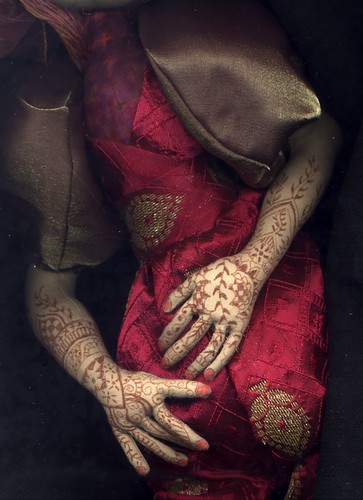

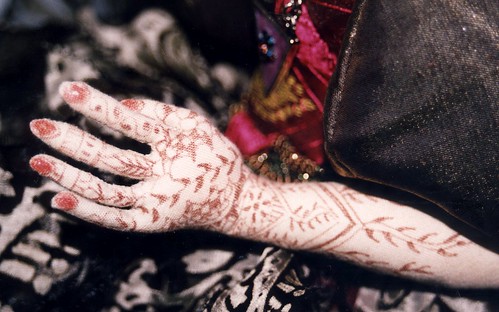
The dolls also had journals for us to write up the process - these are my pages in Khadira's journal:
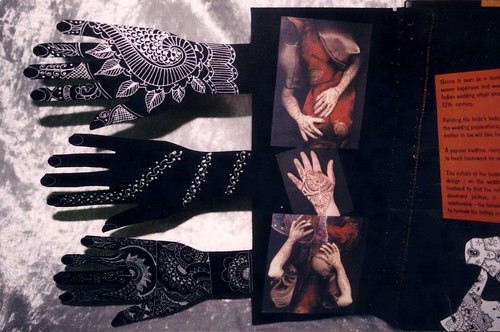
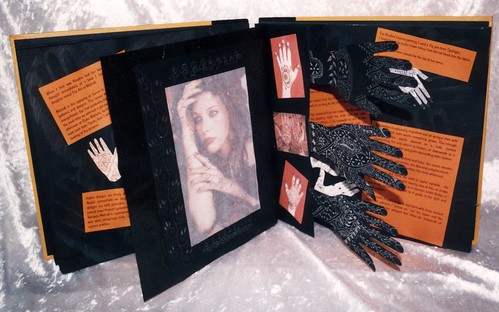
and here is Khadira finished - she is now back with her mum Annette

If anyone is interested in knowing more about Mehndi, these are the research notes I included in the journal:
"When I first saw Khadira and her bare brown arms, I thought immediately of a book I had bought for my daughter called The Art of Mehndi.
Mehndi is the applying of henna to the body in intricate patterns and designs. The henna stains the skin with an orange/brown dye that gradually fades away. I had bought the book after we watched a girl painting henna designs one afternoon at Glebe Markets, so first stop was to borrow the book back from daughter, then I actually read it instead of just looking at the pictures.
And this is what I found out:
Henna is made from the crushed leaves of the henna plant and was used as long as 5000 years ago throughout India, Africa and the middle east.
Henna painting spans many countries and religions but the designs vary greatly - in Islam prayers are said with the palms facing skyward, hands can only be decorated with abstract designs so as to not distract from the prayer.
In India, only the body parts above the navel are considered holy, so religious symbols must be painted above it.
Indian designs are finely drawn floral and paisley, whilst Arabic concentrate on larger floral motifs and African designs are bold geometric.
Henna is seen as a blessing with the power to bring the wearer happiness and wealth and has played a part in the Indian wedding ritual since the moguls introduced it in the 12th century.
Painting the bride's body with henna is an essential part of the wedding preparations, the deeper the stain, the more her mother in law will love her.
A popular tradition claims that the bride-to-be will not have to touch housework for as long as her henna designs last.
The initials of the husband-to-be are hidden in the mehndi design - on the wedding night the bride asks her new husband to find the initials, if he succeeds he will be the dominant partner, if he fails the wife will rule the relationship - the female medndi artists go to great lengths to conceal the initials in their designs.
Symbolism is extremely important and all designs start with the seed (bija) from which everything grows. The triangle (trikona) either points upwards as a male symbol representing fire and ascent to heaven, or downwards as a female symbol of water and grace descending from heaven.
Stars are symbolic of divinity and hope, the square denotes stability, honesty and shelter, the diamond enlightenment.
An octagon symbolises protection, the circle wholeness.
Many flowers and fruits are used as joyful symbols - the lotus is associated with earths bounty, tree of life, an unripe mango (a symbol of virginity) is a common bridal design, a vine is the symbol of devotion as it grows to the light and needs support.
As I decorate Khadira's hands and arms with these ancient traditional patterns I bestow on her the power and the happiness that has followed this ritual for thousands of years."
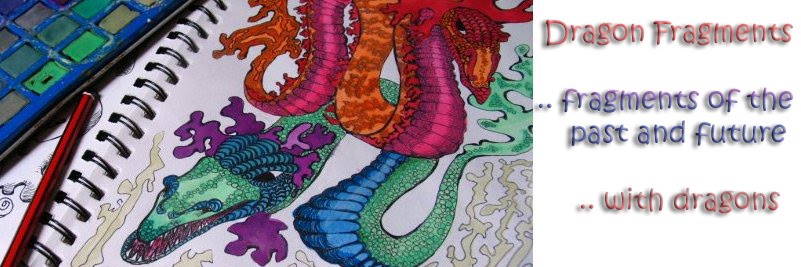
5 comments:
She looks a bit like Alicia Molik... I reckon :-)
well, that shows how much I know about sport, I just had to google to see what Alicia Molik does and looks like (I *have* heard her name mentioned) :)
...you're right, there is a resemblance
Khadira is completely amazing. Beautifull work. Innovative.
thank you, I'm so pleased you enjoyed her, I learned about henna painting traditions while making her.
Thank you very much for sharing this doll. I loved visiting your site - your photos and stories are really well done. Our club is getting ready to start a round robin soon. I have included a link to your post from our blog: www.indyclothdollmakers.org.
Post a Comment